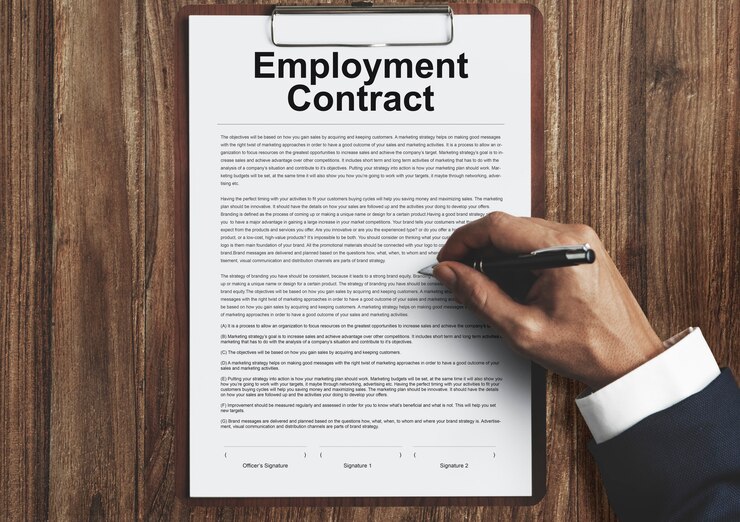
Employment contracts can be written or oral. Still, written contracts are more common and advisable because they clearly record the agreed terms and reduce the risk of misunderstandings and disputes.
In many jurisdictions, certain terms, like minimum wage and workplace safety standards, are regulated by labor laws and cannot be altered through an employment contract to the employee’s detriment.
What Are Employment Contracts?
Employment contracts are legally binding agreements between employers and employees that outline the terms and conditions of employment. These contracts set forth both parties’ rights, responsibilities, and expectations in the employment relationship.
The Key Components Of Employment Contracts Are:
Employment contracts can take various forms, but they typically include the following key components:
1. Job Details
This section specifies the job title, job description, and the employee’s duties and responsibilities. It may also outline the reporting structure, work location, and the employee’s immediate supervisor.
2. Salary and Compensation
The employment contract defines the employee’s compensation, including their base salary or wage, bonuses, commissions, overtime pay, benefits (such as health insurance and retirement plans), and other forms of compensation.
3. Working Hours
The contract may specify the employee’s work schedule, including standard working hours, days of the week, and any overtime or shift work expectations.
4. Termination and Notice
It outlines the circumstances under which employment can be terminated and the notice period required by either party in case of termination. It may also describe the severance or exit package to which an employee is entitled upon termination.
5. Probationary Period
Some contracts include a probationary period during which the employer can assess the employee’s performance before confirming permanent employment. The terms and conditions during the probationary period may be detailed in this section.
6. Non-Compete and Non-Disclosure Clauses
Employment contracts may include clauses restricting the employee from competing with the employer during or after their employment and requiring them to keep company information confidential.
7. Benefits and Perks
The contract often lists employee benefits, such as health insurance, retirement plans, vacation and sick leave, and other incentives.
8. Intellectual Property and Inventions
If the employee’s role involves creating intellectual property or inventions for the employer, this section may address ownership, assignment, and compensation related to such creations.
9. Dispute Resolution
The contract may outline the process for resolving disputes or conflicts, such as through arbitration or mediation rather than litigation.
10. Code of Conduct and Policies
It may reference the company’s code of conduct or other policies the employee must adhere to.
11. Governing Law
The contract may specify the jurisdiction and governing law under which any disputes related to the contract will be resolved.
It’s essential for both employers and employees to carefully review and understand the terms of the employment contract before signing it.
If there are concerns or uncertainties, it’s advisable to seek legal advice or consultation from an employment contract lawyer who can ensure the contract’s compliance with significant labor laws and protects the interests of both parties.
How Do You Create Employment Contracts?

Creating a contract of employment involving several steps ensures that the document accurately reflects the terms and conditions of the employment relationship while complying with relevant labor laws.
Here’s a general guide on how to create an employment contract:
A. Consult with Legal Counsel
Before drafting an employment contract, it’s advisable to consult with an employment attorney or legal counsel who can provide guidance on your specific needs and ensure compliance with labor laws. This is especially important if you have complex or unique employment arrangements.
B. Identify the Parties
Begin the contract by identifying the parties involved—the employer and the employee. Include their legal names and contact information.
C. Position and Job Description
Specify the job title, a detailed job description, and the employee’s duties and responsibilities. Define reporting relationships and the employee’s immediate supervisor.
D. Compensation and Benefits
Outline the employee’s compensation package, including the base salary or wage, bonuses, commissions, overtime provisions, and other forms of compensation. Describe the benefits, such as health insurance, retirement plans, and other perks.
E. Working Hours and Schedule
Detail the standard working hours, days of the week, and any overtime or shift work expectations. Address paid time off, including vacation, holidays, and sick leave.
F. Termination and Notice
Specify the conditions under which employment can be terminated, whether for cause, without cause, or with notice. Outline the notice period required by either party and describe any severance or exit packages in the event of termination.
G. Probationary Period
If applicable, define the terms and conditions of a probationary period during which the employer can assess the employee’s performance before confirming permanent employment.
H. Non-Compete and Non-Disclosure Clauses
Include any non-compete and non-disclosure clauses that restrict the employee from competing with the employer and require the protection of company information.
I. Intellectual Property and Inventions
If the employee’s role involves creating intellectual property or inventions, address ownership, assignment, and compensation for such creations.
J. Dispute Resolution
Specify the process for resolving disputes or conflicts. You may include clauses related to arbitration or mediation as an alternative to litigation.
Conclusion
Understanding employment contracts is an essential aspect of protecting both employers and employees. These contracts form the foundation of the employment relationship, outlining rights, responsibilities, and expectations for all parties involved.
Employers must draft clear and comprehensive agreements that comply with relevant labor laws and regulations, while employees should review and negotiate terms when possible to ensure fairness.
Legal protection in the workplace hinges on a well-crafted employment contract. By addressing crucial elements such as compensation, working conditions, termination clauses, and dispute resolution procedures, these contracts help mitigate conflicts and ensure a smoother employment experience.
In the event of disputes, having a legally sound employment contract can be the key to resolving issues swiftly and fairly. Whether you’re an employer or an employee, taking the time to understand and create strong employment contracts is an investment in a more secure and harmonious working relationship.
Read Also:






